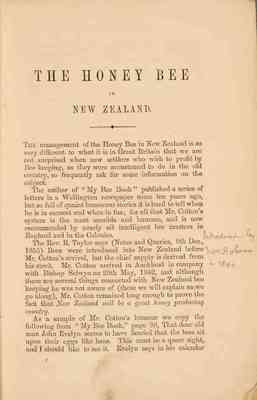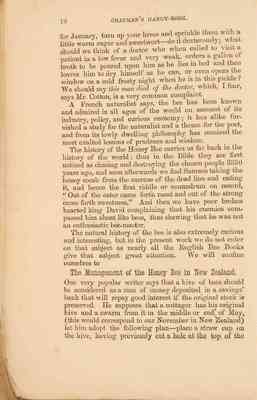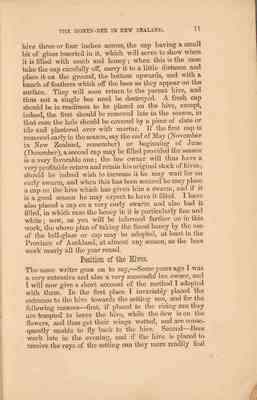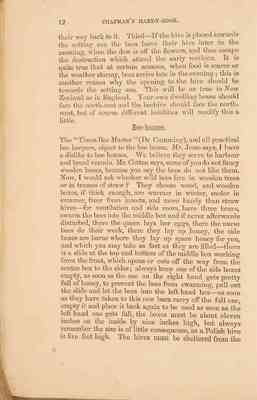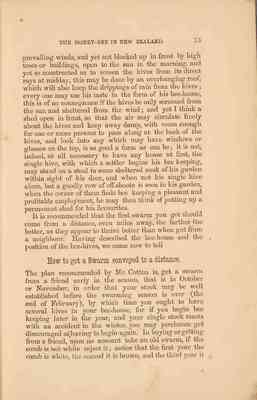Pages
THE HONEY BEE IN NEW ZEALAND
_______._______
The management of the Honey Bee in New Zealand is so very different to what is in Great Britian that we are not surprised when new settlers who wish to profit by Bee keeping, as they are accustomed to do in the old country, so frequently ask for some information on the subject. The author of "My Bee Book" published a series of letters in a Wellington newspapersome ten years ago, but so full of quaint humorous stories it is hard to tell when he is in earnest and when in fun; for all that Mr. Cotton's system is the most sensible and humane, and is now recommended by nearly all intelligent bee masters in England and in the Colonies. The Rev. R. Taylor says (Notes and Queries, 8th Dec., Introduced by 1855) Bees were introduced into New Zealand before Mrs Hobson Mr. Cotton's arrival, but the chief supply is derived from in 1840 his stock. Mr Cotton arrived in Auckland in company with Bishop Selwyn on 29th May, 1842, and although there are several things connected with New Zealand bee keeping he was not aware of(these we will explain as we go along), Mr. Cotton remained long enough to prove the fact that New Zealand will be a great honey producing country. As a sample of Mr. Cotton's humour we copy the following from "My Bee Book," page 96, That dear old man John Evelyn seems to have fancied that the bees sit upon their eggs like hens. This must be a queer sight, and I should like to see it. Evelyn says in his calendar 2
10 CHAPMAN'S HANDY-BOOK
for January, turn up your hives and sprinkle them with a little warm sugar and sweetwort - do it dexterously ; what should we think of a doctor who when called to visit a patient in a low fever and very weak, orders a gallon of broth to be poured upon him as he lies in bed and then leaves him to dry himself as he can, or even opens the window on a cold frosty night when he is in this pickle? We should say this man died of a doctor, which, I fear, says Mr. Cotton, is a very common complaint.
A French naturalist says, the bee has been known and admired in all ages of the world on account of its industry, policy, and curious economy ; it has alike furnished a study for the naturalist and a theme for the poet, and from its lowly dwelling philosophy has received the most exalted lessons of prudence and wisdom.
The history of the Honey Bee carries us far back in the history of the world : thus in the Bible they are first noticed as chasing and destroying the chosen people 3350 years ago, and soon afterwards we find Samson taking the honey comb from the carcase of the dead lion and eating it, and henced the first riddle or conundrum on record, "out of the eater came forth meat and out of the strong came forth sweetness." And then we have poor broken hearted king David complaining that his enemies compassed him about like bees, thus shewing that he was not an enthusiastic bee-master.
The natural history of the bee is also extremely curious and interesting, but in the present work we do not enter on that subject as nearly all the English Bee Books give that subject great attention. We will confine ourselves to
The Management of the Honey Bee in New Zealand.
One very popular writer says that a hive of bees should be considered as a sum of money deposited in a savings' bank that will repay good interest if the original stock is preserved. He supposes that a cottager has his original hive and a swarm from it in the middle or end of May, (this would correspond to our November in New Zealand) let him adopt the following plan - place a straw cap on the hive, having previously cut a hole at the top of the
THE HONEY-BEE IN NEW ZEALAND. 11
hive three or four inches across, the cap having a small bit of glass inserted in it, which will serve to show when it is filled with comb and honey ; when this is the case take the cap carefully off, carry it to a little distance and place it on the ground, the bottom upwards, and with a bunch of feathers whisk off the bees as they appear on the surface. They will soon return to the parent hive, and thus not a single bee need be destroyed. A fresh cap should be in in readiness to be placed on the hive, except, in that case the hole should be covered by a piece of slate or tile and plasted over with mortar. If the first cap is removed early in the season, say at the end of May (November in New Zealand, remember) or the beginning of June (December), a second cap may be filled provided the season is a very favourable one ; the bee owner will thus have a very profitable return and retain his original stock of hives ; should he indeed wish to increase it he may wait for an early swarm, and when this has been secured he may place a cap on the hive which has given him the swarm, and if it was a good season he may expect to have it filled. I have also placed a cap on a very early swarm and also had it filled, in which the honey in it is particularly fine and white ; now, as you will be informed farther on in this work, the above plan of taking the finest honey by the use of the bell-glass or cap may be adopted, at least in the Province of Auckland, at almost any season, as the bees work nearly all the year around.
Position of the Hives The same writer goes on the say,- Some years ago I was a very extensive and also a very successful bee owner, and I will now give a short account of the method I adopted with them. In the first place I invariablyplaced the entrance to the hive towards the setting sun , and for the following reasons - first, if placed to the rising sun they are tempted to leave the hive, while the dew is on the flowers, and thus get their wings wetted, and are consequently unable to fly back to the hive. Second-Bees work last in the evening, and if the hive is placed to receive the rays of the setting sun they more readily find
12 CHAPMAN'S HANDY-BOOK
their was back to it. Third--If the hive is placed towards the setting sun the bees leave their hive later in the morning, when the dew is off the flowers, and thus escape the destruction which attend the early workers. It is quite true that at certain seasons, when food is scarce or the weather stormy, bees arrive late in the evening; this is another reason why the opening to the hive should be towards the setting sun. This will be as true in New Zealand as in England. Your own dwelling house should face the north-east and the beehive should face the northwest, but of course different localities willmodify this a little. Bee-houses. The "Times Bee Master" (Dr. Cumming), and all practical bee keepers, object to the bee house. Mr. Jesse says, I have a dislike to bee houses. We believe they serve to harbour and breed vermin. Mr. Cotton says, some of you do not fancy wooden boxes, because you say the bees do not like them. Now, I would ask whether wild bees live in wooden trees or in trusses of straw? They choose wood, and wooden boxes, if thick enough, are warmer in winter, cooler in summer, freer from insects, and more handy than straw hives - for ventilation and side room, have three boxes, swarm the bees into the middle box and if never afterwards disturbed, there the queen lays her eggs, there the nurse bees do their work, there they lay up honey, the side boxes are barns where they lay up spare honey for you, and which you may take as fast as they are filled - there is a slide at the top and bottom of the middle box working from the front, which opens or cuts off the way from the centre box to the sides; always keep one of the side boxes empty, as soon as the one on the right hand gets pretty full of honey, to prevent the bees from swarming, pull out the slide and let the bees into the left hand box - as soon as they have taken to this new barn carry off the full one, empty it and place it back again to be used as soon as the left hand one gets full, the boxes must be about eleven inches on the inside by nine inches high, but always remember the size is of little consequence, as a Polish hive is five feet high. The hives must be sheltered from the
THE HONEY-BEE IN NEW ZEALAND 13
prevailing winds and yet not blocked up in front by high trees or buildings, open to the sun in the morning , and yet so constructed as to screen the hives from its direct rays at midday, this may be done by an ovdrhanging roof, which will also keep the drippings of rain from the hives ; every one may use his taste in the form of his bee-house, this is of no consequence if the hives be only screened from the sun and sheltered from the wind ; and yet I think a shed open in front, so that the air may circulate freely about the hives and keep away damp, with room enough for one or more persons to pass along at the back of the hives, and look into any which may have windows or glasses on the top, is as good a form as can be ; it is not, indeed, at all n ecessary to have nay house at first, the single hive, with which a settleer begins his bee-keeping, may stand on a stool in some sheltered nook of his garden within sight of his door, and when not his single hive alone, but a goodly row of off-shoots is seen in his garden, when the own er of them finds bee keeping a pleasant and profitable employment, he may then think of putting up a permanent shed for his favourites.
It is recommended that the first swarm you get should come from a distance, even miles away, the farther the better, as they appear to thrive better than when got from a neighbour. Having described the bee-house and the position of the bee-hives, we come now to tell
How to get a Swarm conveyed to a distance
The plan recommended by Mr. Cotton is, get a swarm from a friend easly in the season, that is in October or November, in order that your stock may be well
